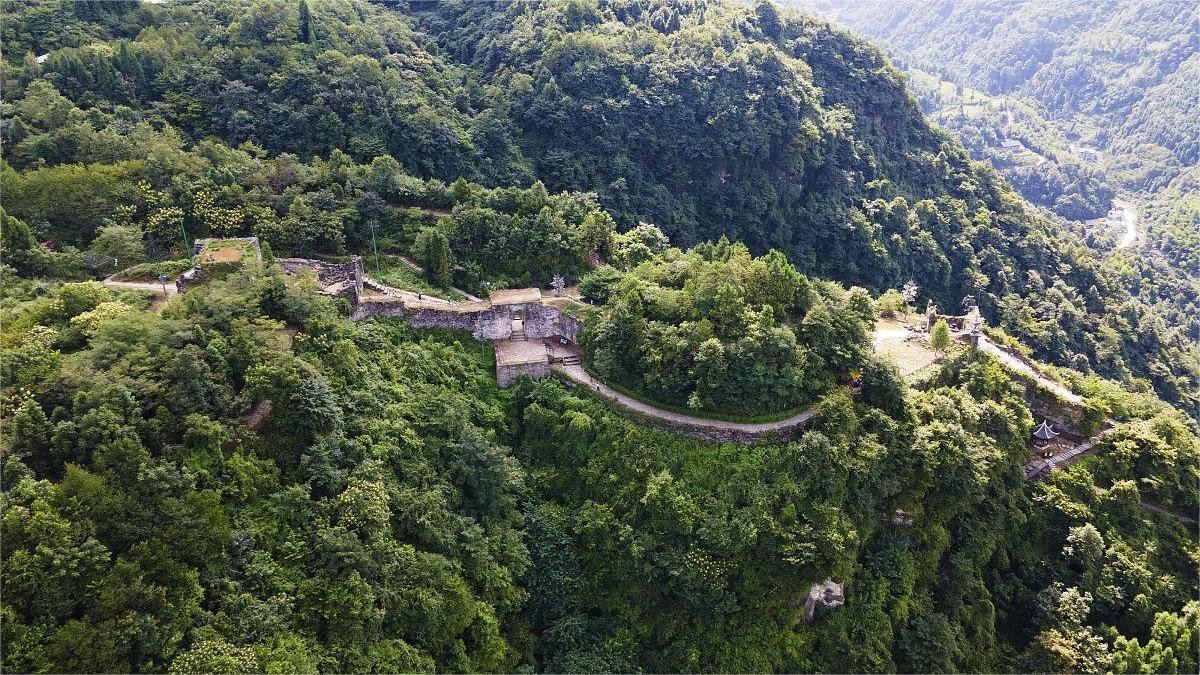Hailongtun Tusi Fortress (海龙屯土司遗址), constructed in the fifth year of the Bao You era of the Southern Song Dynasty (1257 AD) and destroyed during the Ping Hua Campaign in the twenty-eighth year of the Wanli era of the Ming Dynasty (1600 AD), stands as a unique relic in Guizhou Province. It is the only large-scale military and palace complex in the region, representing a well-preserved medieval castle site in China and even Asia, earning it the nickname “China’s Machu Picchu” by archaeologists.
Surrounded by mountains and solitary peaks, Hailongtun resembles a slender-necked gourd, with its northern, eastern, and southern sides facing the main source of the Xiang River, the “Baisha River,” all of which are sheer cliffs. The fortress features multiple layers of walls, including the Moon City and Earth City, with three layers of walls encircling the reservoir, presenting a winding and majestic appearance akin to the Great Wall of China.
Hailongtun witnesses the evolution of China’s minority policies from the Tusi system to the “change soil into rivers” policy. It is renowned as the main battlefield of the famous “Ping Hua Campaign,” witnessing both the glory and downfall of the Yang family’s rule over Bizhou.
Table of Contents
- Basic Information
- Location and Transportation
- Map of Hailongtun Tusi Fortress
- Highlights of Hailongtun Tusi Fortress
- Vlog about Hailongtun Tusi Fortress
Basic Information
| Estimated Length of Tour | Half a day |
| Ticket Price | 65 RMB |
| Opening Hours | 9.00 – 17.00; Last admission: 16.00 (1st November – 31st March) 8.30 – 18.00; Last admission: 16.30 (1st April – 31st October) |
| Telephone Number | 0086-0851-23270077 |
Location and Transportation
Hailongtun Tusi Fortress is located in Hailongtun Village, Gaoping Town, Huichuan District, Zunyi, Guizhou Province, atop the Longyanshan Mountain, approximately 28 kilometers northwest of Zunyi City.
To get there, visitors can reach Zunyi City by high-speed train or bus first. From there, they can take the Tourism Bus Route 2 from Zunyi People’s Congress (Zhuhai Road) or the direct shuttle bus from Maocaopu Bus Station near the gas station to Hailongtun Scenic Area.
Map of Hailongtun Tusi Fortress

Highlights of Hailongtun Tusi Fortress
Copper Pillar Pass

Copper Pillar Pass, situated on the southern slope of the eastern mountainside of Hailongtun, serves as the first line of defense for those entering from the southeast. Originally built during the Southern Song Dynasty and reinforced during the Ming Dynasty, it is constructed with blue stones and lime mortar, featuring a single-channel semi-circular vaulted top. Despite its partial destruction, remnants stand at 6.68 meters tall, with a width of 10 meters and a depth of 5.75 meters, preserving one column top stone and one paved stone.
Iron Pillar Pass

Iron Pillar Pass, located on the northern slope of the eastern mountainside of Hailongtun and facing south, serves as the counterpart to the Copper Pillar Pass, forming a strategic position to control access from the northeast. Positioned above a valley and equipped with a drawbridge, it secures the northern gateway to the fortress. Similar to its counterpart, it was originally built during the Southern Song Dynasty and reinforced during the Ming Dynasty. Constructed with blue stones and lime mortar, it employs a vertical interlocking vault method, featuring a single-channel semi-circular vaulted top designed for a drawbridge. Despite some collapse, remnants reach a height of 5.2 meters, with a width of 6.3 meters and a depth of 4.2 meters.
Dragon-Tiger Avenue

Dragon-Tiger Avenue, also known as Longhu Avenue, serves as a crucial military thoroughfare linking Feilong Pass and Feihu Pass. Carved out of cliffs, this 292-meter-long passage, with a width ranging from 1.5 to 4 meters, likely served as a hidding place for soldiers. The avenue, flanked by cliffs on one side and a ravine on the other, features a parapet wall on the outer edge and drainage ditches along the inner side. Its construction not only facilitated transportation but also provided materials for building walls and passes. Submerged underground after the Battle of Pingxi, it resurfaced in 1999, offering a glimpse into its historical significance.
New Palace

The New Palace, functioning as the political center during wartime, resembles the layout of government offices, featuring halls, pavilions, ponds, warehouses, and barracks spread across an area exceeding 20,000 square meters. Its architecture centers around a multi-tiered stepped pathway, flanked by structures arranged in a symmetrical layout. The grand stone foundations of the preserved buildings, with the largest platform spanning 50 meters, showcase sturdy construction. The main building interiors are paved with plain blue bricks, while the courtyards feature stone slabs. Enclosed by a stone wall measuring 504 meters in length, the New Palace encompasses an area of 18,000 square meters, divided into three main sections: the central area for handling administrative affairs, and the western and eastern sections for additional functions.



I drove to Hailongtun and climbed the mountain alone in the rain. With no other tourists around, it was somewhat scary.
The visitor center is still a bit of a distance from the foot of the mountain, and you need to take a sightseeing bus. The bus ride to the foot of the mountain takes about 10-15 minutes. Compared to the Zunyi Meeting Site, there are really very few tourists here. It’s a particularly niche and meaningful attraction.
At an altitude of over 1,000 meters, the ecology of Tunpu is excellent and incredibly beautiful. The hike up is about 2.5 km one way. It was a bit drizzly today, and many of the original stone paths were slippery, so it’s advisable to wear hiking shoes. Even if you’re not particularly interested in the cultural sites, it’s still worth a visit. The nearby Tusi Town has a vibrant atmosphere and unique character, with various activities during holidays. On non-holidays,… Read more »